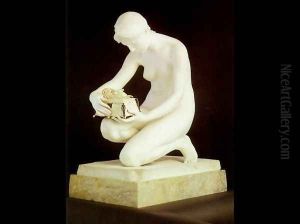Harry Bates Paintings
Harry Bates was a British sculptor, born in 1850 in Stevenage, Hertfordshire, England. He was one of the most prominent figures associated with the New Sculpture movement, which sought to bring a greater sense of realism and vitality to British sculpture during the late 19th century. Bates began his career in the arts at an early age, apprenticing under the sculptor J. W. Taber before moving on to work for the well-known sculptor Lord Leighton. It was during this time that Bates was exposed to classical sculpture and the Renaissance masters, which had a significant influence on his work.
Bates furthered his education at the Royal Academy Schools, where he won several medals and scholarships, including the prestigious travelling scholarship, which allowed him to study in Rome. His time in Italy further ingrained in him a love for classical art, which would be reflected in his own sculptures. Upon returning to England, Bates became a founding member of the Art Workers' Guild, which promoted the unity of all the visual arts, rejecting the hierarchy that placed fine arts above the decorative arts.
Throughout his career, Bates was known for his allegorical works and portrait busts. One of his most famous works is the bronze statue 'Pandora', which showcases his ability to blend classical themes with a modern approach to form and detail. His work was well-received, and he exhibited at the Royal Academy and other venues. Bates' sculptures are characterized by their intricate detail, emotional depth, and technical skill.
Sadly, his career was cut short when he died prematurely in 1899 at the age of 49. Despite his relatively brief career, Harry Bates left a lasting impact on British sculpture and is remembered for his contribution to the New Sculpture movement.
